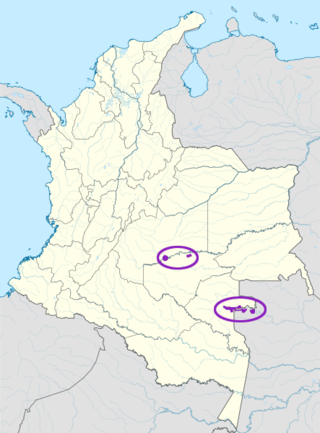

| Tucano | |
|---|---|
| Dahseyé | |
| Native to | Brazil, Colombia |
| Ethnicity | Tucano people |
Native speakers | 4,600 in Brazil (2006)[1] 7,020 in Colombia (2012), including Pisamira[1] |
| |
| Official status | |
Official language in | |
| Language codes | |
| ISO 639-3 | Either:tuo – Tucanoarj – Arapaso |
| Glottolog | tuca1252 Tucanoarap1275 Arapaso |
| ELP | Tukano |
| Arapaso[2] | |
 | |
Tucano, also TukanoorTucana, endonym Dahseyé (Dasea), is a Tucanoan language spoken in Amazonas, Brazil and Colombia.
Many Tariana people, speakers of the endangered Tariana language are switching to Tucano.
| Bilabial | Alveolar | Palatal | Velar | Glottal | ||
|---|---|---|---|---|---|---|
| Plosive | plain | p | t | k | ʔ | |
| voiced | b | d | ɡ | |||
| Nasal | (m) | (n) | (ŋ) | |||
| Fricative | s | h | ||||
| Trill | r | |||||
| Approximant | w | j | ||||
Nasal sounds [m n ŋ] are variants of voiced stops /b d ɡ/ between nasal vowels. Stops may also be heard as prenasalized [ᵐb ⁿd ᵑɡ] after nasal vowels. /w/ can be heard as a nasal bilabial semivowel [β̞̃] in the environment of nasal vowels. Allophones of /ɾ/ can be heard as [ɾ̃], [ɺ].[3][4]
| Front | Central | Back | |
|---|---|---|---|
| High | i ĩ | ɨ ɨ̃ | u ũ |
| Mid | e ẽ | o õ | |
| Low | a ã |
|
| |||||||||
|---|---|---|---|---|---|---|---|---|---|
| Western |
| ||||||||
| Eastern |
| ||||||||
| Unclassified |
| ||||||||
Italics indicate extinct languages | |||||||||
|
| |||||||||||||||||||||||
|---|---|---|---|---|---|---|---|---|---|---|---|---|---|---|---|---|---|---|---|---|---|---|---|
| Official language |
| ||||||||||||||||||||||
| Regional languages |
| ||||||||||||||||||||||
| Indigenous languages |
| ||||||||||||||||||||||
| Interlanguages |
| ||||||||||||||||||||||
| Sign languages |
| ||||||||||||||||||||||
| Non-official |
| ||||||||||||||||||||||